

| Summer 2008 | ||||||||||||
| Current Issue | ||||||||||||
| Seeing smarter Against all odds Keeping the doors open Reach out and touch someone They have a dream Moving forward Clinical care From the Executive VP |
||||||||||||
| Past Issues Other Publications Contact Us Make a Gift WHSC home |
||||||||||||
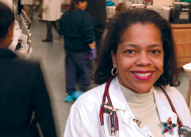 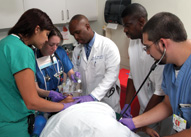
|
||||||||||||
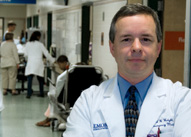
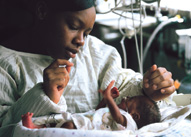
| "Without Grady, should Atlanta have the misfortune to experience a terrorist attack or a major passenger airline crash, we would be woefully unprepared to care for the many injured persons." —Louis Sullivan, a member of Grady's governing board and former U.S. Health and Human Services secretary. |

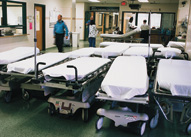
| "We committed to raise another $100 million over the next four years, and to have every expectation we can do more than that. So we are well on the way with capital funding." — Pete Correll, co-chair of the task force to save Grady. |
By Martha Nolan McKenzie
A little more than a year ago, it looked as if Atlanta’s Grady Memorial Hospital was poised to follow in the footsteps of Philadelphia General, D.C.’s General Hospital, and Martin Luther King Hospital in Los Angeles. These public hospitals all closed their doors, forced out of business by spiraling health care costs, falling funding, and rising numbers of uninsured patients.
However, Grady apparently had something the other hospitals lacked—a committed, visionary, and influential group of supporters, who were determined that the hospital must survive. They were able to bring on board a disparate group of political, business, and civic leaders, creating the momentum needed to turn around a vast ship like Grady. Today the hospital has new leadership, an infusion of funding, and a plan for moving forward.
“The community stepped forward and rallied behind its mission and goals. That is what saved Grady,” says Michael Johns, who was CEO of Emory’s Woodruff Health Sciences Center when the fiscal and governance crisis began more than a year ago and is now Emory University chancellor.
Grady’s mission, established with the hospital’s creation in 1892, is to care for the city’s indigent. “It serves our local citizens in its safety net role as it wraps its arms around the disenfranchised,” Katherine Heilpern, chair of emergency medicine at Emory, wrote in an editorial in the Atlanta Journal-Constitution. “They turn to Grady for help because it’s ‘their’ hospital, or because they have been turned away by everyone else: the underinsured who can’t make a cash co-pay, the homeless, victims of interpersonal violence too frightened to speak, the resource poor with chronic mental illness, diabetes, hypertension, congestive heart failure, addiction, and asthma.”
But Grady’s importance reaches far beyond its charity mission. Staffed by Emory and Morehouse physicians, it has one of the nation’s leading trauma centers. In fact, it offers the only level 1 trauma center serving Metro Atlanta and North Georgia—the next closest being in Macon or Chattanooga. It operates the state’s only poison control center, Atlanta’s only burn center, and one of the country’s largest and most comprehensive HIV/AIDS programs. And Grady is the training ground for future doctors, nurses, and other health care professionals. Indeed, one out of four doctors in Georgia trained at Grady through Emory or Morehouse.
To fully appreciate the hospital’s importance, consider life without it. “If Grady disappears, our city’s health care system will be thrown into crisis,” says Louis Sullivan, former U.S. Health and Human Services secretary and a member of Grady’s new governing board. “Our low-income citizens will have a much more difficult time obtaining the care they need and deserve. The special services Grady has available for all of us, such as trauma care, the poison center, the cancer center, and others, will no longer be available. The other hospitals and clinics in Atlanta will not be able to fill the void in health services that would be created if Grady closes. Without Grady, should Atlanta have the misfortune to experience a terrorist attack or a major passenger airline crash, we would be woefully unprepared to care for the many injured persons.”
The loss of Grady would deal Atlanta an economic blow as well. Without Grady, Atlanta would be at a competitive disadvantage in attracting organizations and businesses to locate here, says Sullivan. “Atlanta’s convention business, a major part of our economy, would also suffer significantly.”
All the services Grady provides, while critical, are costly. The deans of both Emory and Morehouse can attest that medical education is expensive. Trauma, burns, HIV/AIDS, tuberculosis, neonatal intensive care, and teaching are not profitable ventures.
And while Grady’s costs have mounted, its funding has failed to keep pace. In fact, annual contributions from Fulton and DeKalb counties have been flat for the past 15 years, while funding from the state actually has shrunk. In addition, Medicare, Medicaid, and private insurers have cut reimbursement rates in an effort to control costs, and the number of uninsured has ballooned. Today, 40% of the patients Grady treats lack any type of insurance.
Rising costs plus shrinking income equals a lot of red. Grady has operated at a loss for 10 of the past 11 years. It finished last year with a $55 million deficit, and one foot poised above the grave.
Rallied by a new sense of urgency, the Metro Atlanta Chamber of Commerce stepped up and—with the Fulton-DeKalb Hospital Authority’s consent—created a task force to develop a plan to resuscitate the hospital. Prominent leaders from diverse businesses and institutions— including Emory’s Johns and Morehouse School of Medicine President John Maupin—lent their time, experience, and talents to the effort.
“This was all about trying to preserve Grady’s historic mission and raising the money to get that done,” says Pete Correll, chairman emeritus of Georgia-Pacific and co-chair of the task force. “Nobody wanted to be involved in running a bankrupt hospital. But here was a unique opportunity to fix Grady if we all came together and were committed.”
In July of 2007, the task force issued a concise, 23-page report outlining its recommendations for Grady, which centered on changes in governance and funding. “The task force report was the sea change in the whole process,” says Thomas Lawley, dean of Emory’s medical school. “The fact that it was prepared by an independent group of people who had no direct stake in Grady lent tremendous credibility.”
High on the list of recommendations was revamping the hospital’s structure from the hospital authority model, characterized by the report as “outdated competitively and a barrier to necessary change,” to a 501(3)c nonprofit organization, governed by a non-political, private board. The new 17-member board reads like a Who’s Who of Atlanta business and community leaders. Chaired by Correll, it includes Sullivan, prominent attorneys, CEOs of several large corporations, the Atlanta school superintendent, and others.
“The idea of replacing the politically appointed board with a board whose primary fiduciary responsibility was to the hospital and its mission was a critical piece for success,” says Johns. “These are people who understand the community, the mission, and the politics, and they can get out there and really work for the success of this organization. They have leadership ability, but they also have clout. People will listen to them.”
The change in management cleared the way for Grady to receive promised funding of hundreds of millions of dollars in private donations and government funding, including a life-saving pledge of $200 million over four years from the Robert W. Woodruff Foundation. The promise of this money, which will be used to buy equipment and support other non-operating costs, was a key incentive in winning support to convert Grady’s management structure.
How did this windfall come about? Correll simply asked for it. “The foundation had been monitoring the Grady situation for 10 to 20 years,” he says. “They had been approached hundreds of times about support, but they had not been comfortable with the previous governance structure. But, as they have many times in our community, they took the lead. The magnitude of the gift has caught everyone’s attention, and it will make it easier for us to raise the balance of what we need.
“We’ve committed to raise another $100 million over the next four years, and I have every expectation we can do more than that,” continues Correll. “So we are well on the way with capital funding. We still have a long way to go toward improving the operations and getting additional operating funding.”
Indeed, some hoped-for operating funding already has fallen through. Although the outlook for legislation to fund a statewide trauma care network was optimistic, the General Assembly ended its 2008 session without approving the bill. The legislation could have provided up to $30 million annually for Grady. Instead, the legislature made a one-time appropriation for trauma care of $58 million, of which $24 million is expected to go to Grady.
“Hopefully, the trauma bill will be back on the table in the next session,” says Johns. “It’s good for Grady and the entire state. It saves lives, and it’s just the right thing to do.”
The hospital needs to shave its operating costs by $50 to $60 million a year, says Correll. “That means the people working at the hospital need to accept that they are going to have to dramatically change what they do and how they do it.”
Despite the challenges ahead, Grady has managed to get off the critical list and is taking the first steps toward recovery.
“This city, unlike so many others that faced a similar challenge, has come together,” says Morehouse’s Maupin. “Disparate opinions from disparate groups all filtered down to one message: Grady is vital and needs to thrive. I think we now have the will, the wherewithal, and the expertise to turn the crisis into a model public hospital.”
As Johns adds, “Now the hard work begins.”
Current Issue | Past Issues | Contact Us | Make a Gift
Back to Top | WHSC home
© 2008. Emory University, All rights reserved.
Back to Top | WHSC home
© 2008. Emory University, All rights reserved.